

“The practice of art isn’t to make a living,”
Kurt Vonnegut said. “It’s to make your soul grow.”
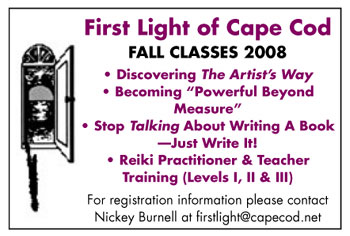
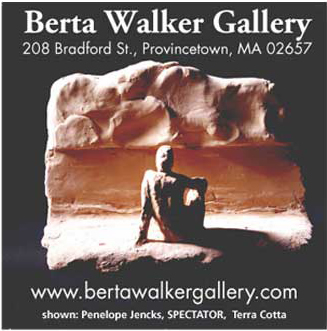
Discovering The Artist’s Way
by Nicola Burnell

I'D HEARD THE BUZZ about The Artist’s Way long before a friend handed me a copy. The claims that it held the keys to living a more creative life both intrigued and unnerved me. Like many Artist’s Way students, this book found me when I was ready to embark upon the journey of a lifetime.
Author Julia Cameron planted the seeds for this bestselling book in humble soil while teaching a series of creative recovery classes out of a Chicago living room. When Mark Bryan joined one of these classes he recognized the importance of the ideas Julia was sharing and encouraged her to document them. Her weekly class “notes” became The Artist’s Way. “I put on the page what I had been putting into practice for a decade,” she writes in her introduction. Dedicating the book to Mark, Julia acknowledges his support, saying that “without him it would not exist.”
When I interviewed Mark Bryan, he was passionate yet humble about his role in the creation of The Artist’s Way. “We were really passing on to others what a group of very important people gave to us,” he said. “We developed and honed that work into what it is and self-published the book together.”
The Artist’s Way is not just for creative people. While it can do fatal damage to creative blocks, it can also help liberate anyone who feels stuck or in need of change in their life. “Artistry is in everything we do,” explains Mark, who co-founded The Artist’s Way Workshops. “Creativity is the ability to think and feel, and find new creative solutions to any problem in our lives.”
Our creative spirit knows how to have fun, live spontaneously, and nurture itself. Re-acquainting ourselves with this side of our nature is what The Artist’s Way is all about. Many people who begin this process claim they don’t have an ounce of creativity in them, yet they still feel drawn to it. This book is a doorway to self knowledge and motivation. Working like a golden key, it offers the reader access to the wealth of creativity they were born with.
Imagine yourself, for a moment, standing in front of a splintered doorway that leads to a long-locked attic. Your curious “child self” wants to venture into the dusty old attic, but your “adult self” is terrified of what you may find in there. Could there be monsters? Yes, of course there could! But there could also be long lost treasures just waiting to be rediscovered.
As the facilitator of many Artist’s Way groups, I understand the trepidation of those first tentative steps. I know the twists, turns, and hurdles of this carefully constructed path, having walked it myself many times. The baby steps I have taken on this personal journey into my own creativity have been the most terrifying, exciting, and fulfilling steps of my life. The spiritual tools offered in this book taught me how to change my life and showed me practical, effective ways to create the life I’d always hoped for. The Artist’s Way helped guide me toward my dreams.
Subtitled “A Spiritual Path To Higher Creativity,” The Artist’s Way directly addresses the needs of the soul. Although “God” appears throughout the text, Julia clearly states that she is referring to the concept of creative energy, or universal flow. To succeed in the process “no god concept is necessary,” she writes.
While the book deals with spiritual concepts, this is not a religious text. It is a guide, or map, to the “Great Creator” within us all. The pages introduce, then support the idea that creativity and spirituality come from the same “source.” Many “creatives,” the book suggests, feel stuck when they don’t recognize the true source of their creativity. The image of long-suffering artists prepared to bleed to death for their work may sound romantic, but surely artists get tired of struggling?
Creative people often fester away in lives that crucify their creativity simply because they don’t realize there is a way out. Thanks to The Artist’s Way, a creative life is not reserved for a lucky few, it is for anyone willing to pursue it.
Before reading The Artist’s Way, many people are unaware that they have “creative wounds,” or that they learned to block their creativity at a young age. They attribute their inability to follow their creative path to either laziness, a failure to commit, or lack of talent. This explains why so many “almost finished” novels reside in boxes, why the last drop of paint never makes it onto the canvas, and why a tune lives only in a musician’s head.
The first half of The Artist’s Way focuses on excavating old creative wounds. Julia refers to this process as “spiritual chiropractic.” It identifies situations that are draining and reveals where negative patterns began. As students work through the issues that come up, their feelings are given validation.
People often feel blocked, for example, when they unconsciously carry limiting judgments made by “Creative Monsters” who scorned their efforts to create in the past. Once a “Creative Monster” is discovered, students find ways to put this demon to rest. I had one student who made a soft clay model of her monster. She then took great pleasure in running it over with her truck until it was nothing but multicolored blobs among the stones of her driveway.
Other “blocked creatives” do daily battle with what Julia Cameron calls “crazymakers.” These are people who are skilled at draining other people’s energy. They disregard schedules, triangulate everyone they deal with, and always expect special treatment. By distracting themselves with the whims and problems of the crazymaker, a blocked creative can avoid facing their own creative dreams. Julia writes: “As frightening and abusive as life with a crazymaker is, we find it far less threatening than the challenge of a creative life of our own.”
Once a student identifies who their crazymakers are, they can stop the “tortured tango” and learn to set healthy boundaries to protect themselves from their destructive behavior.
THE ARTIST'S WAY begins with the signing of a “Creativity Contract” where students commit to the process. This includes “excellent self-care” and employing the “Basic Tools,” which are non-negotiable requirements of the course.
The first Basic Tool is the “Morning Pages,” which teach us how to silence the internal critic, or censor, that crushes creativity before it has a chance to grow. By filling three pages with stream-of-consciousness writing, every day, students begin a dialogue with their creative self and slowly discover what drains and inspires them. “I learned to just show up at the page and write down what I heard,” writes Julia.
These are sacred journals that are kept private and confidential. “You want safety as a central theme, particularly in the early weeks,” stresses Mark. “The process of having to do something that puts you first, every day, is important. It is a reflection about your wants, needs and moods. The Pages can provide insight into a new self perspective.”
Resistance to the Morning Pages is huge when students are not used to writing down their true thoughts. “I was afraid to write, afraid that someone might read it and get offended,” says Brewster artist Coco Larrain, who first completed The Artist’s Way in 1999. “This gave me permission to write. What a release! It helped me to get a clear feeling of who I am.”
The second Basic Tool is the “Artist’s Date,” which teaches self-care. This weekly “play date” can be anything from going to a movie, to reading in the tub. It’s a wonderful way to “refill the well” of creativity. By honoring the need for self-nurturing, the more difficult hurdles of The Artist’s Way are easier to negotiate.
Each of the twelve chapters ends with a series of Tasks. While some Tasks feel like homework, others take you to the beach, the woods, or a new gallery. They are designed to build resolve to complete the course, while gradually challenging the student to set goals and make changes. The combination of the text, Morning Pages, Artist’s Dates, and Tasks gradually pushes the student toward inner and outer transformation.
The Artist’s Way speaks to the inner child, gently drawing it out of the shadows, inviting it to play with creative energy. When Coco first began this process she was what Julia calls a “Shadow Artist.” The responsibilities of being a single working mother meant Coco was not able to focus on her art as much as she would like. “The concept of the Shadow Artist just stabbed me in the heart,” she recalls. “It made me realize my fears were keeping me from going where I wanted to go.”
Sometimes, becoming a Shadow Artist is a necessary step in the direction of creative goals and can be considered a form of mentoring. Once students recognize themselves as Shadow Artists, the next step is to come out of the shadows and into their own creative light.
Committing to her art was a key part of Coco’s path to creative recovery. She converted her garage into an art studio where she painted a series of large canvases to honor her recently deceased parents. (See sidebar about Coco’s journey along The Artist’s Way)
This sense of growth and movement is experienced by many Artist’s Way students who consciously step into the flow of living a more creative life. By opening up to their own potential as creative beings, they show faith in their creativity and are more likely to take creative risks, which in turn lead to creative empowerment.
The journey of The Artist’s Way draws you into the very core of your creative being. No-one can take this journey for you, but you can travel with companions. I teach The Artist’s Way as a twelve-week course, working through the chapters one week at a time.
Our first task is to build a “sacred circle” of trust, which is critical for the success of a group setting. Julia lists ten Sacred Circle Rules that set the tone for these gatherings. The first rule establishes that “Creativity flourishes in a place of safety and acceptance.”
It was the group setting that helped Coco to really work on her issues. “I found it tremendously supportive,” she says. “It was always hard when the attention came to me, but I realized this was a group of people who believed in me. They pushed me beyond my own limits and made me face my fears. They gave me strength, encouragement, and belief. It was very, very supportive.”
Every Artist’s Way group is unique. “Within the structure of The Artist’s Way there’s a definite organic-ness to what’s happening in the group,” observes Mark. Some groups feel so connected with each other that they continue the process after the twelve weeks are completed; others go back to Week One and start all over again.
continued on next column . . .
An Artist’s Journey
into Creative Recovery
by Nicola Burnell & Coco Larrain
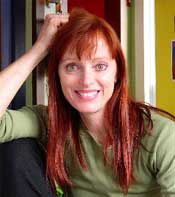
BEFORE MOVING to the Cape, Brewster artist Coco Larrain worked in New York as a commercial artist, having gone to school to study illustration. “I focused my education around commercial art because I didn’t think I could survive as a fine artist,” she admits. When she was diagnosed with breast cancer in 1997, Coco returned to her canvas. “I knew I had to paint.” She produced a self portrait, entitled “Chemo Going Through Me, Me Going Through Chemo,” which is a haunting expression of her experience with cancer. After being declared cancer free in 1999, however, Coco was still afraid of committing to her art. She then discovered The Artist’s Way.

Before reading the book, Coco was a Shadow Artist who did not believe that she could turn her creative dreams into reality. “I’d suppressed my desire to paint because I never thought it possible that one day I’d be a painter.” She believes her experience with The Artist’s Way gave her permission to change her work schedule so that she could spend more time painting.
“I believe that’s why I survived cancer,” she says. “The creative spirit gave me the strength to leave New York and guided me here. It also gave me a reason to allow myself to create and give back to that energy and that source which saved me.”
Coco stepped out of her Shadow Artist self in 2004 when she began offering commissioned portraits of pets. By combining her love of animals with her love of painting, she found she could capture a unique glimpse into the soul of her clients’ pets.

Above: "Self Joy" by Coco Larrain
When she was invited to paint a sculpture of a large whale for the Cape and Islands Whale Trail exhibition and auction in 2006, she poured her passion and concern for the mammals into her whale. “The most important thing was to bring attention to the dire situation our great mammals are currently facing,” she explains. Her entry, called Stop, Protect, Connect, raised the highest price at the auction, 90 percent of which went to the Whale and Dolphin Conservation Society. “It felt fantastic to have my creative efforts reap such a positive reward!”
Coco pushed herself to new creative depths when she began work on a series of five large paintings to honor her parents, who had died in 2006 within four months of each other. “With each stroke of the brush I felt them observe me as I silently—and at intense moments not so silently—conversed with them,” Coco explains. “I was searching to connect with their souls out there in the depth of the skies that I struggled to paint.”
When Coco increased the scale of her canvas—ten times larger than her previous work—to capture the vastness of “out there,” she set herself up for challenges that resurrected her old Creative Monsters. “There were so many times that I ‘hit the wall,’ bombarded by cacophonous internal dialogues of resistance, of being a failure, of frustration, and a desperate desire to quit.”
Amid this creative angst, Coco was given the book Art & Fear: Observations On The Perils (and Rewards) of Artmaking, by David Bayles & Ted Orland. “It was uncanny to discover this book speaking directly to me about exactly what I was going through,” she remembers. Taking comfort from this text, while also reflecting on her process with The Artists Way, Coco was pushed through the revolving doors of her resistance.
“I was finally facing all my fears, which, until then, had kept me being a shadow artist. My ‘Morning Pages,’ and all those probing questions that dissected my past, were suddenly whisked away as it all became clear and I understood why I hadn’t allowed myself to dive into painting as a career, let alone even try.”
Citing the process of creating art as “very painful, mentally and physically,” Coco recognized that “if it’s easy, we’re not growing. The viewer of the final work doesn’t know this, and it doesn’t really matter.”
Finally embracing gratitude for the gift of her ability, inherited from her artist grandmothers, and her determination to not give up, Coco gave herself permission to embrace the artist that had always lived within her. “I was finally doing what I’ve always dreamed of. Quit? Because it was harder than I thought? No, no possible way.”
Shortly after she began her large paintings, Coco was offered an exhibition in a year’s time. “This completely supported my choice to venture into the unknown,” she says. In The Artist’s Way, Julia Cameron refers to this as “synchronicity,” and she quotes W.H. Murray’s thoughts on commitment: “. . . the moment one definitely commits oneself, then Providence moves too . . . . ” (The Scottish Himalayan Expedition.)
Coco exhibited her new work, the Beyond Sky series, along with fifteen commissioned pet portraits, at the Brewster Ladies Library for the month of April this year. The show also included a self portrait, entitled “Jubilant,” where Coco depicts herself as laughing and joyous, “in celebration of having survived breast cancer.”
Although she has experienced success as an artist, Coco still does battle with her “Censor” as she works to resolve her issues around abundance and letting go of fear. “Fears never really go away,” she admits as she compares her art to that being exhibited in New York’s Arcadia Fine Arts Gallery. Her Censor’s ugly taunts suggest “Who am I kidding? My work doesn’t even come close to these works.”
Despite her Censor’s efforts to derail her creative goals, Coco is expanding her portfolio in preparation to take another step toward her dream. She is planning a series of small landscapes and still lifes, while adding to the large scale landscape series of her recent exhibition. “I need at least 20 paintings in a series to present to galleries for representation,” she explains. “At that point I will contact a few galleries on the Cape, and the Arcadia Fine Arts Gallery, which specializes in realism.”
Almost a decade after discovering The Artist’s Way, Coco continues to be inspired by Julia Cameron’s words of wisdom. “When I get insecure, I go back and reread the book, and it charges me again.”
COCO LARRAIN has exhibited in solo and group exhibitions both on Cape Cod and in New York City. An interview on Coco by National Public Radio entitled “The Price of Paradise” can be heard on http://www.wgbh.org/cainan/. Coco lives in Brewster with her son, Lasco. Her work can be viewed at www.cocosportraits.com
. . . . . . . . . . . . . . . . . . . . . . . . .
The Artist's Way
Continued from previous column:
Mark tells his groups they are on the journey for one moment of enlightenment that can change a student’s life forever. “That moment will be different for each of you,” he says. I have seen this “one moment” occur in my groups. It is the “Aha!” that follows a personal insight, often triggered through class discussion. “The work was built to speak specifically to people,” explains Mark. “It excites me to watch the light go on in people’s eyes. It really touches me, because it’s a very important thing when someone looks at you and they feel and look different than they did before you started.”
The Artist’s Way is an ongoing process for students and facilitators. Many of my students mirror my own experiences, which I share with them. “What’s important is that the facilitator is involved in a current evolution of his or her own creative process,” says Mark. “It’s very important that facilitators have a current creative challenge they are engaged in, from which they can draw experience, in real time, to discuss and to bring to the group.”
He also says the purpose of a teacher is to make themselves “lovingly and gently superfluous.” The Artist’s Way is not meant to be a crutch; it is a tool for empowerment and growth. This process will take you as far as you want to go, at your own pace. This makes the transition to a more creative life a matter of just taking the next step, as it appears, rather than dramatic leaps.
When people thank Mark and Julia for changing their lives with The Artist’s Way, they reply “No, thank you! YOU changed your life, we’re glad we could help.” Mark believes this kind of feedback is profoundly important. “Somebody helped us, like we helped each other,” he says.
In true Artist’s Way tradition, Julia does not claim ownership of the tools she shares, but lovingly and generously offers them to anyone who feels ready to discover them. “The tools in this book are intended as life-savers. Please use them and pass them on.”
Nicola Burnell is the editor of this magazine. For more information about The Artist’s Way go to www.artistswayatwork.com. For information on upcoming ‘Discovering The Artist’s Way’ classes email Nicola@capewomenonline.com
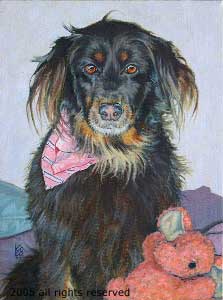
"Tula," portrait of a dog by Coco Larrain
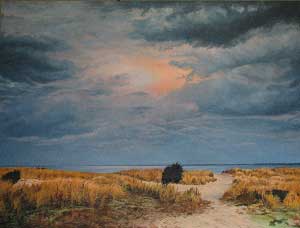
Coco Larrain, "Stranger on the Shore"
21 in Truro Exhibition
at Highfield Hall, Falmouth
September 6–October 31
““21 in TRURO” is a group of women painters who have been meeting in Truro since 2000, for a week in September, to paint together. They will exhibit their work at historic Highfield Hall, in Falmouth, this fall.
Next year, in celebration of the 300th Anniversary of the Town of Truro, Massachusetts, artists from Truro, England will show their paintings with artists from Truro, Cape Cod, at the Highland House Museum. This will also mark the 10th anniversary of the 21 in TRURO group. Highland House Museum Curator Deborah Minsky and the 21 in TRURO Committee will be organizing the show. Members of the Town Counselors from Truro, England, will visit Cape Cod next year in honor of this celebration.
The 21 in TRURO group consists of artists LaVerne Christopher, Michele D’Angelo, Jane Eccles, Maryalice Eizenberg, Sarah Fielding-Gunn, Susan A. Hollis, Joan Ledwith, Jane Lincoln, Jerre Moriarty, Rosalie Nadeau, Kate Nelson, Carol Odell, Julie Siler Olander, Suzanne M. Packer, JoAnn Ritter, M’Lou Sorrin, Lorraine Trenholm, Christie Velesig, Barbara Wylan, Linda S. Young, and Joyce Zavorskas.
Chatham Artist Carol Odell
Joins 21 in Truro
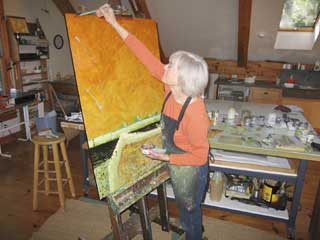
Carol Odell is an abstract studio artist who creates paintings in oil and encaustic, as well as monotypes. She says of joining the group of women artists: “Unlike a school of art, 21 in TRURO is bound by an attitude of support, consideration and respect rather than a common style, practice or philosophy. All members, for sure, are dedicated artists, but vary in experience, techniques, and styles. There seems to be a shared respect for image making, but not one credo."
"The retreat is in a beautiful place that is removed from the responsibilities of daily schedules," says Carol. "Here we can sketch or paint, but mostly relax, reflect, share, and support each other. My experience with the group is just beginning. I have known quite a few of the members, but not all, so I am looking forward to getting to know this community of artists better. Working artists, for the most part, are on a solitary journey which has many rewards, but also some pitfalls. Associating with other working artists, for me, is reassuring that the journey is worthwhile and re-enforces my belief in the validity of individual visions.”
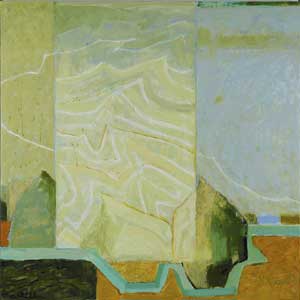
Carol Odell, “Clear Wandering”
oil on linen mounted on panel,
48” x 48”
Carol Odell shows her work at her studio/gallery at 423 Main Street in Chatham www.odellarts.com, and at the Left Bank Gallery in Wellfleet www.leftbankgallery.com
For more information or to order a catalog, go to www.highfieldhall.org
. . . . . . . . . . . . . . . . . . . . . .
